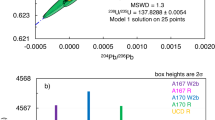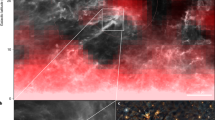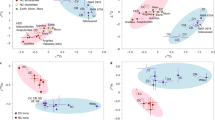Abstract
The age of the Solar System can be defined as the time of formation of the first solid grains in the nebular disc surrounding the proto-Sun. This age is estimated by dating calcium–aluminium-rich inclusions in meteorites. These inclusions are considered as the earliest formed solids in the solar nebula. Their formation marks the beginning for several long- and short-lived radiogenic clocks that are used to precisely define the timescales of Solar System events, such as the formation and evolution of planetary bodies1,2,3. Here we present the 207Pb–206Pb isotope systematics in a calcium–aluminium-rich inclusion from the Northwest Africa 2364 CV3-group chondritic meteorite, which indicate that the inclusion formed 4,568.2 million years ago. This age is between 0.3 (refs 4, 5) and 1.9 (refs 1, 6) million years older than previous estimates and is the oldest age obtained for any Solar System object so far. We also determined the 26Al–26Mg model age of this inclusion, and find that it is identical to its absolute Pb–Pb age, implying that the short-lived radionuclide 26Al was homogeneously distributed in the nebular disc surrounding the proto-Sun. From the consistently old ages in the studied inclusion, we conclude that the proto-Sun and the nebular disc formed earlier than previously thought.
This is a preview of subscription content, access via your institution
Access options
Subscribe to this journal
Receive 12 print issues and online access
$259.00 per year
only $21.58 per issue
Buy this article
- Purchase on Springer Link
- Instant access to full article PDF
Prices may be subject to local taxes which are calculated during checkout



Similar content being viewed by others
References
Amelin, Y., Krot, A. N., Hutcheon, I. D. & Ulyanov, A. A. Lead isotopic ages of chondrules and calcium–aluminium-rich inclusions. Science 297, 1679–1683 (2002).
Nyquist, L. E., Kleine, T., Shih, C. Y. & Reese, Y. D. The distribution of short-lived radioisotopes in the early Solar System and the chronology of asteroid accretion, differentiation, and secondary mineralization. Geochim. Cosmichim. Acta 73, 5115–5136 (2009).
Wadhwa, M., Srinivasan, G. & Carlson, R. W. in Meteorites and the Early Solar System II (eds Lauretta, D.S. & McSween, H.Y. Jr) 715–732 (Univ. Arizona Press, 2006).
Bouvier, A., Wadhwa, M. & Janney, P. E. 26Al–26Mg and 207Pb–206Pb systematics in an Allende inclusion. Meteorit. Planet. Sci. 41, A5299 (2008).
Jacobsen, B. et al. 26Al–26Mg and 207Pb–206Pb systematics of Allende CAIs: Canonical solar initial 26Al/27Al ratio reinstated. Earth Planet. Sci. Lett. 272, 353–364 (2008).
Amelin, Y. et al. Modern U–Pb chronometry of meteorites: Advancing to higher time resolution reveals new problems. Geochim. Cosmochim. Acta 73, 5212–5223 (2009).
Wadhwa, M. et al. Ancient relative and absolute ages for a basaltic meteorite: Implications for timescales of planetesimal accretion and differentiation. Geochim. Cosmochim. Acta 73, 5189–5201 (2009).
MacPherson, G. J. et al. Early solar nebula condensates with canonical, not supracanonical, initial 26Al/27Al ratios. Astrophys. J. Lett. 711, L117–L121 (2010).
Bouvier, A., Blichert-Toft, J., Moynier, F., Vervoort, J. D. & Albarède, F. Pb–Pb dating constraints on the accretion and cooling history of chondrites. Geochim. Cosmochim. Acta 71, 1583–1604 (2007).
Young, E. D. et al. Supra-canonical 26Al/27Al and the residence time of CAIs in the solar protoplanetary disk. Science 308, 223–227 (2005).
Thrane, K., Bizzarro, M. & Baker, J. A. Extremely brief formation interval for refractory inclusions and uniform distribution of 26Al in the early Solar System. Astrophys. J. Lett. 646, L159–L162 (2006).
Amelin, Y., Janney, P. E., Chakrabarti, R., Wadhwa, M. & Jacobsen, S. B. Isotopic analysis of small Pb samples using MC-ICPMS: The limits of precision and comparison to TIMS. Eos Trans. AGU (Fall Meeting Suppl.) 89, Abstr. V13A-2088 (2008).
Scott, E. R. D., Keil, K. & Stoeffler, D. Shock metamorphism of carbonaceous chondrites. Geochim. Cosmochim. Acta 56, 4281–4293 (1992).
Krot, A. N., Scott, E. R. D. & Zolensky, M. E. Alteration and dehydration in the parent asteroid of Allende. Meteorit. Planet. Sci. 30, 530–531 (1995).
Richter, S. et al. New average values for the n(238U)/n(235U) isotope ratios of natural uranium standards. Int. J. Mass Spectrom. (2010, in the press).
Bizzarro, M., Baker, J. A. & Haack, H. Mg isotope evidence for contemporaneous formation of chondrules and refractory inclusions. Nature 431, 275–278 (2004).
Wadhwa, M., Janney, P. E. & Krot, A. N. Al–Mg isotope systematics in Efremovka E60 CAI: Evidence of re-equilibration. Meteorit. Planet. Sci. 44, A5431 (2009).
Cherniak, D. J. Pb diffusion in Cr diopside, augite, and enstatite, and consideration of the dependence of cation diffusion in pyroxene on oxygen fugacity. Chem. Geol. 177, 381–397 (2001).
LaTourrette, T. & Wasserburg, G. J. Mg diffusion in anorthite: Implications for the formation of early Solar System planetesimals. Earth Planet. Sci. Lett. 158, 91–108 (1998).
Ito, M. & Ganguly, J. Mg diffusion in minerals in CAIs: New experimental data for melilites and implications for the Al–Mg chronometer and thermal history of CAIs. Lunar Planet. Sci. Conf. XL A1753 (2009).
Brennecka, G. et al. 238U/235U variations in meteorites: Extant 247Cm and implications for Pb–Pb dating. Science 327, 449–451 (2010).
Brennecka, G. et al. Toward reconciling early Solar System chronometers: The 238U/235U ratios of chondrites and D’Orbigny pyroxenes. Lunar Planet. Sci. Conf. XLI A2117 (2010).
Spivak-Birndorf, L., Wadhwa, M. & Janney, P. E. 26Al–26Mg systematics in D’Orbigny and Sahara 99555 angrites: Implications for high-resolution chronology using extinct chronometers. Geochim. Cosmochim. Acta 73, 5202–5211 (2009).
Quitté, G. et al. Correlated iron 60, nickel 62, and zirconium 96 in refractory inclusions and the origin of the Solar System. Astrophys. J. Lett. 655, 678–684 (2007).
Tachibana, S., Huss, G. R., Kita, N. T., Shimoda, G. & Morishita, Y. 60Fe in chondrites: Debris from a nearby supernova in the early Solar System? Astrophys. J. Lett. 639, L87–L90 (2006).
Connelly, J., Amelin, Y., Krot, A. N. & Bizzarro, M. Chronology of the Solar System’s oldest solids. Astrophys. J. Lett. 675, L121–L124 (2008).
Krot, A. N., Yurimoto, H., Hutcheon, I. D., Glenn, J. & MacPherson, G. J. Chronology of the early Solar System from chondrule-bearing calcium–aluminium-rich inclusions. Nature 434, 998–1001 (2005).
Villeneuve, J., Chaussidon, M. & Libourel, G. Homogeneous distribution of 26Al in the Solar System from the Mg isotopic composition of chondrules. Science 325, 985–988 (2009).
Weidenschilling, S. J., Marzari, F. & Hood, L. L. The origin of chondrules at jovian resonances. Science 279, 681–684 (1998).
Tatsumoto, M., Knight, R. J. & Allègre, C. J. Time differences in the formation of meteorites as determined from the ratio of lead-207 to lead-206. Science 180, 1279–1283 (1973).
Acknowledgements
We are grateful to T. Bunch for allocating the meteorite specimen from the collection at Northern Arizona University, to Y. Amelin for providing access to the Pb isotope data that was acquired in collaboration with M.W. at ASU (and illustrated in Supplementary Fig. S3) and to R. Hines and P. Janney for their assistance in the Isotope Cosmochemistry and Geochronology Laboratory at ASU. This work was funded by grants from the NASA Cosmochemistry Program and NASA Origins of Solar Systems Program to M.W.
Author information
Authors and Affiliations
Contributions
A.B. and M.W. planned the project. A.B. carried out the analytical work during her post-doctoral appointment. Both authors discussed the results and contributed to the writing of this manuscript.
Corresponding author
Ethics declarations
Competing interests
The authors declare no competing financial interests.
Supplementary information
Supplementary Information
Supplementary Information (PDF 1061 kb)
Rights and permissions
About this article
Cite this article
Bouvier, A., Wadhwa, M. The age of the Solar System redefined by the oldest Pb–Pb age of a meteoritic inclusion. Nature Geosci 3, 637–641 (2010). https://doi.org/10.1038/ngeo941
Received:
Accepted:
Published:
Issue Date:
DOI: https://doi.org/10.1038/ngeo941
This article is cited by
-
Igneous meteorites suggest Aluminium-26 heterogeneity in the early Solar Nebula
Nature Communications (2023)
-
Dynamical orbital evolution of asteroids and planetesimals across distinct chemical reservoirs due to accretion growth of planets in the early solar system
Journal of Astrophysics and Astronomy (2023)
-
Origin of life-forming volatile elements in the inner Solar System
Nature (2022)
-
Late veneer and the origins of volatiles of Earth
Acta Geochimica (2022)



